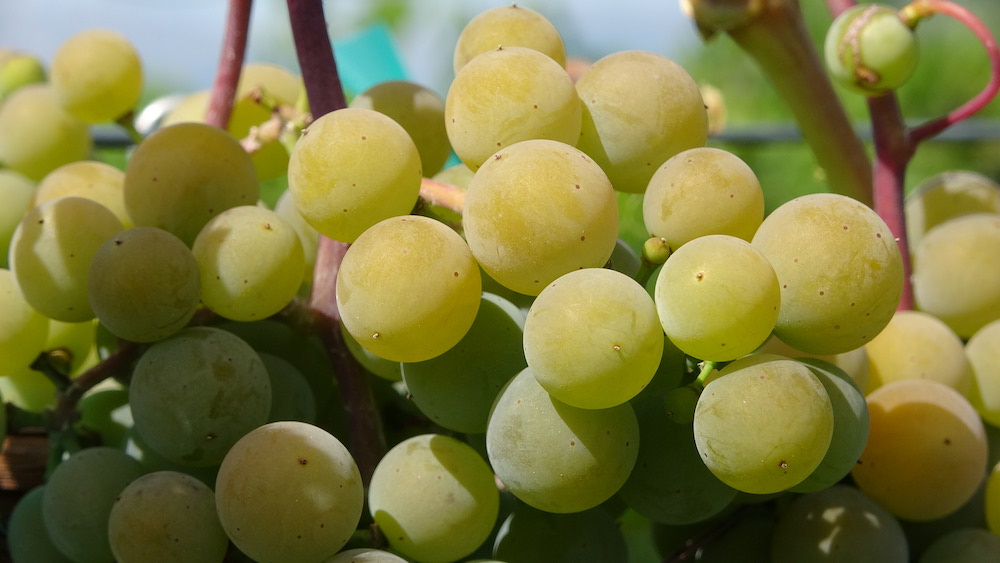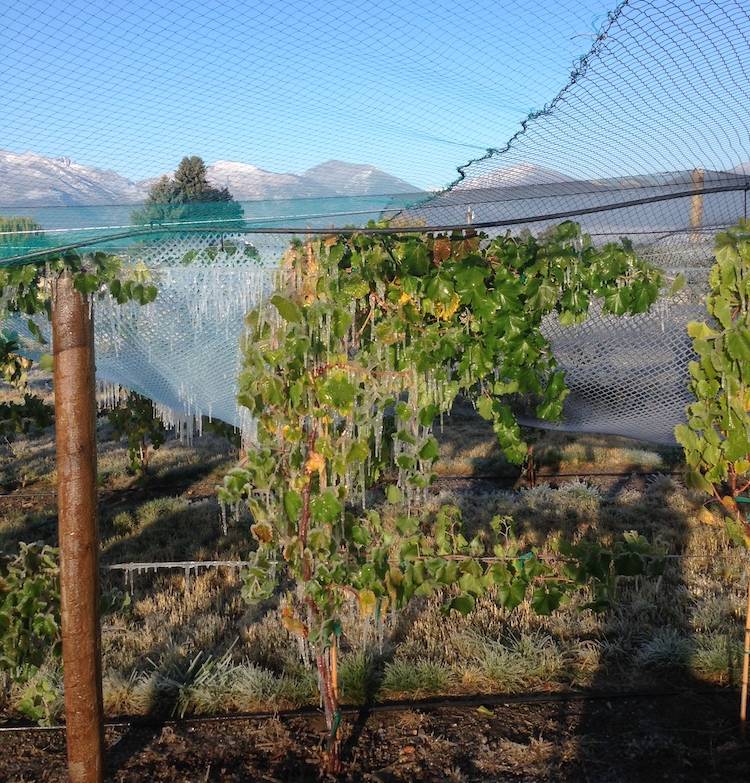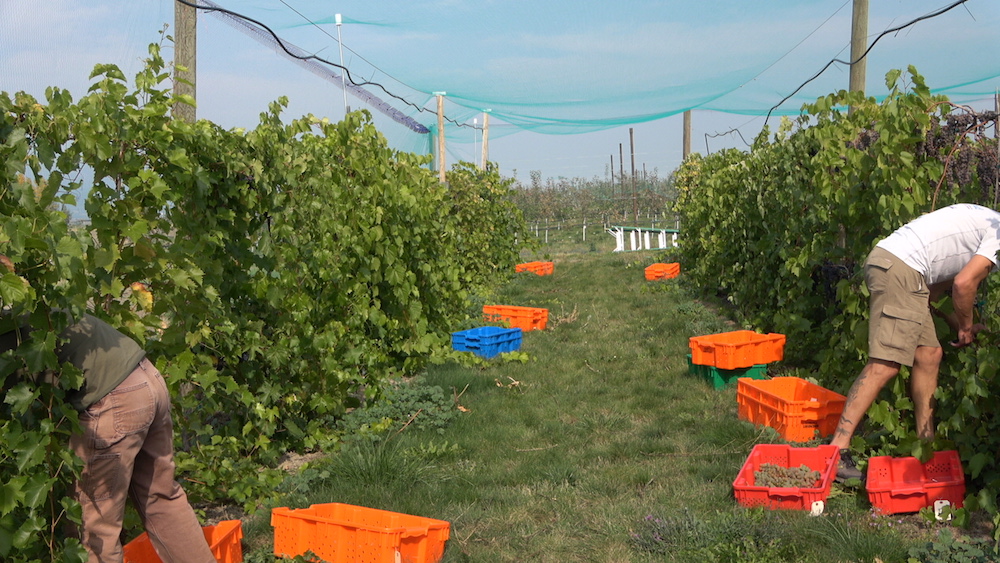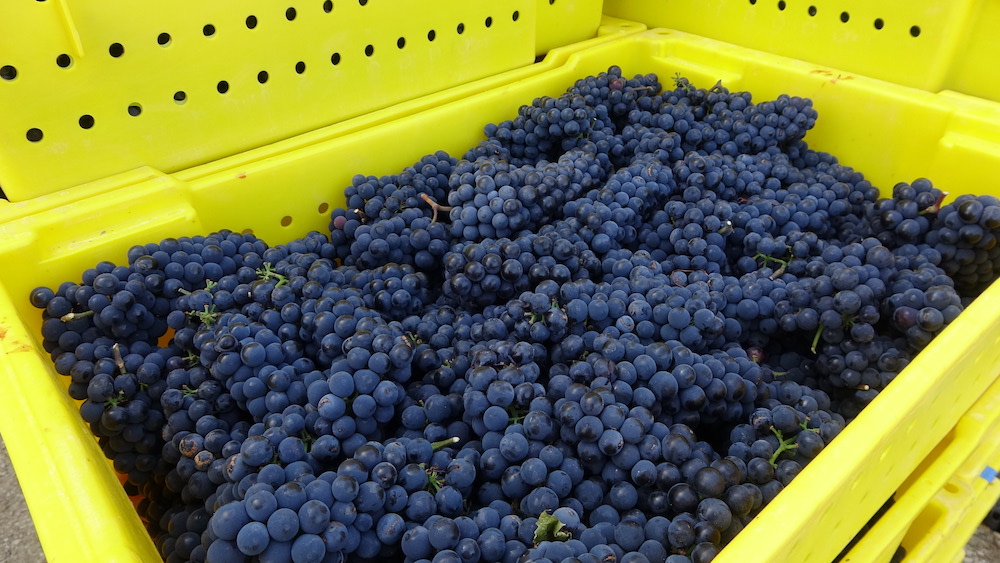Harvesting Quality Fruit
Deliciously plum St. Pepin grapes, nearly ready for harvest.
Harvest timing
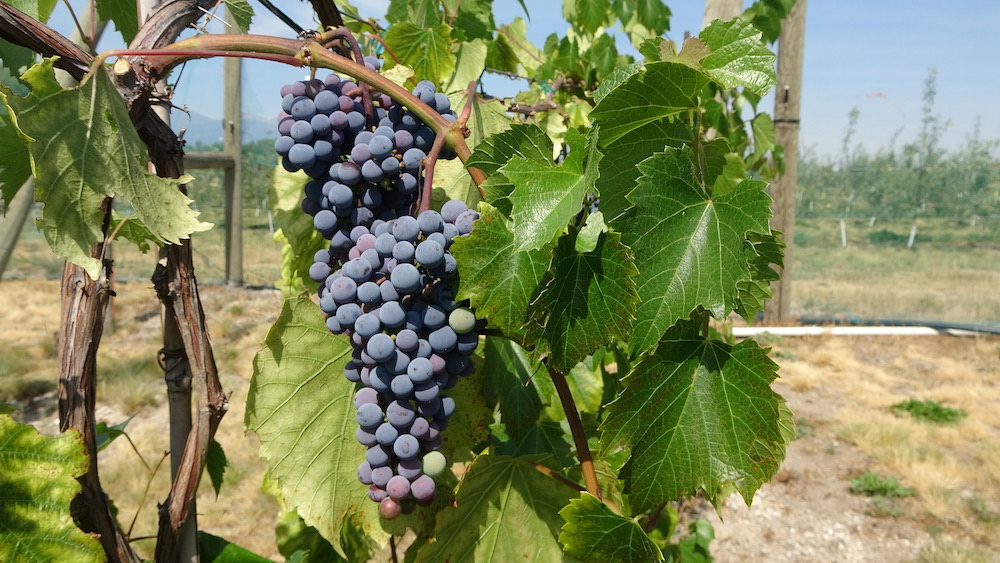
Despite reaching the end of their veraison period in October, these late-ripening Bluebells didn't reach their ideal Brix level for harvest.
Harvesting grapes at the appropriate stage is critical for wine quality. The Minnesota Grape Growers Association offers a PDF resource detailing the state of the grapes at each phase of their maturation, which explains why close monitoring is so important in having a successful harvest.
Growing Degree Days
Grape ripening is driven by temperature that controls the conversion acids into sugars. The speed of ripening is measured by growing degree days (GDD), which integrates the amount of time the temperature is above the threshold where plants are growing (50° F for grapes). The common cold-hardy grape varieties (e.g. Frontenac or Marquette) are reported to require 2500-2600 growing degree days (base 50° F, Haggerty 2014) to reach maturity and optimal juice quality in the Midwest and Northeast. While these long, hot growing seasons are common in the Yellowstone River valley, they are relatively rare in western Montana where most of the vineyards are located. For example, based on the last 25 years of climate data, the Bitterroot Valley has had growing seasons with greater than 2400 growing degree days (base 50⁰ F) in one of every six years. You can find similar data for your own region by using the single sine model in the USPEST website’s GDD calculator.
°Brix
The two best tools for measuring °Brix are a refractometer (either handheld or digital) and a hydrometer. Most growers will have both instruments—the refractometer for measuring °Brix in the field leading up to harvest, and the hydrometer for taking measurements from larger juice samples, often post-harvest during processing. Most wine varieties are best harvested around a level of 22-24° Brix. There is some variability, as sweet table wines benefit from higher °Brix at harvest, while some sparkling and white table wines can be harvested in the range of 17-21° Brix. That said, most cold-hardy varieties that can ripen during the short Montana growing season will benefit from a minimum of 22° Brix at harvest. As soon as a variety is at nearly 100% coloration, °Brix should be measured twice weekly. Collect berries (at least 10 per sample) from several different vines of the same variety. Place those berries in a small zippered plastic bag, manually them thoroughly to produce an adequate volume of juice, cut off lower corner of the bag, and squeeze a few drops of the juice onto the refractometer for a reading. Do this for all varieties as they each reach full coloration.
pH/TA

Many growers and winemakers choose a Vinmetrica for testing the juice and eventually the wine from their grapes.
A simple pH meter and a beaker or other small container are required for measuring pH, which requires a bit more juice (minimum of 15 berries) than for measuring °Brix. The ideal pH range for most cold-hardy grape varieties is between 3.2 and 3.5, but this can err slightly more acidic for certain varieties (usually white wine grapes).
Total/Titratable Acidity (TA) can be measured with an inexpensive acid test kit or—if you are making your own wine—a pricier pH/TA analyzer kit (e.g., Vinmetrica). The analysis is simple but can take some practice, so read the kit instructions carefully. Titratable Acidity readings should fall in the range of 6.0 - 9.0. Once all of these measurements—°Brix, pH, and TA—are within the ideal ranges for your varieties’, the grapes are ready for harvest. However, since most northern hybrid grapes are characteristically high in acids, often growers will harvest these grapes before the TA has dropped into the optimal range.
As you approach the desired thresholds for each variety, start planning for harvesting labor and material needs, such as harvesting totes and refrigeration space (post-harvest processing will be discussed later in this section).
Late season frosts
Late season frosts are the bane of grape growers’ existence in Montana. While cold-hardy varieties are bred to withstand colder and longer winters, they—like any other grape—are highly susceptible to frost damage during the growing season. While there isn’t much growers can do to prepare for sudden dramatic or sustained frosts that can occur in the early fall, there are damage-preventative measures for less severe frosts. One method is to coat vines with water using sprinklers or overhead misters just before temperatures drop. The water freezes around the foliage and berries, creating an insulating effect underneath the ice. That said, do not coat the vines with too much water, as an overly thick layer of ice can cause the leaves to drop prematurely in the days after thawing.
If you have grapes that have reached full maturity before an oncoming frost, harvest them immediately to avoid frost damage to the fruit. If grapes are not have not fully ripened before the frost arrives, they will need to be harvested immediately following the frost, as the fruit will stop ripening. Leaving grapes on the vine after a frost can cause vines to sustain further damage that will impair their ability to survive the winter (Grape Maturation and Ripening, MGGA, PDF).
These vines in WARC's research vineyard were misted a bit too heavily before a frost in 2018, resulting in what we like to call "grapecicles."
Harvesting methods
WARC staff hurriedly harvest the last of their grapes before an imminent October frost.
While there are a number of mechanical harvesting methods that can be useful for larger operations, we will focus on hand-harvesting techniques, as most of the vineyards in Montana operate on a smaller scale.
Aim for harvesting on a cool, dry day, as dry grapes will store longer than wet grapes. Equipment—harvest bins, clippers, etc.—should be clean, sharp, and ready for action. Label bins or other storage containers to keep varieties organized. If you’re not planning to transfer your harvest immediately to a buyer or another location for processing, prepare an adequate storage space for your loaded bins.

A grape razor fork can be a safe and efficient tool for harvesting.
There are a couple different harvesting tools to choose from. One option is to use sharp pruning shears/clippers (we prefer the more scissor-like trimmers with narrow tips) rather than pulling clusters by hand, as this will ensure you’re not damaging the vine or knocking off other clusters. Another handy and potentially safer harvesting tool is the “grape fork” or razor. To pick a cluster with either tool, hold a cluster with one hand and clip/cut just above each cluster on its small stem, or “peduncle.” Assess the cluster and pluck out any diseased/rotten fruit or insects (a good use of the narrow-tipped shears). Watch for for Asian Lady Beetles, as merely one crushed beetle in a wine must can send the whole batch off flavor. If you’re harvesting table grapes, you may want to take more time with this step, plucking out any shrivelled or unappealing berries (or add this step to the processing phase). When the cluster passes your inspection, toss it in the bin and move onto the next cluster. Keep bins out of direct sunlight, preferably in a cooler, shady area during harvest.
This video offers a quick overview of grape harvesting: Harvesting Grapes (VIDEO, Minnesota Grape Growers Association)
Sharp trimmers and freshly harvested Somerset Seedless grapes.
Post-harvest storage and processing
Storage
If you plan to sell your harvest fresh, transport the grapes as quickly as possible to the buyer(s). If storing your grapes onsite for longer than a few days, keep in mind that optimal shelf-life under refrigeration is just a few weeks. Optimal storage conditions are just above 32°F with a humidity of 75-80%. If you are using your grapes for juice (rather than fresh eating), freezing the grapes is also an option. Note that washing the grapes is not typically necessary and can even be detrimental to grape quality, as it can dilute the sugars and acids in the berries.
Weighing yields
Weigh yields for each variety and divide this weight by the number of vines harvested to obtain a measurement for yield per vine of each variety. This will help you understand your vineyard’s output each season, which will inform your changes in canopy management, fertilization, irrigation, etc. for the next season. It can even help you decide whether you might benefit from swapping out one variety for another in your vineyard. Take notes if you run into any irregularities, challenges, or other stand-out observations both during harvest and throughout the growing season. You will thank yourself as you start to see the unique patterns and opportunities for improvement in your vineyard!

